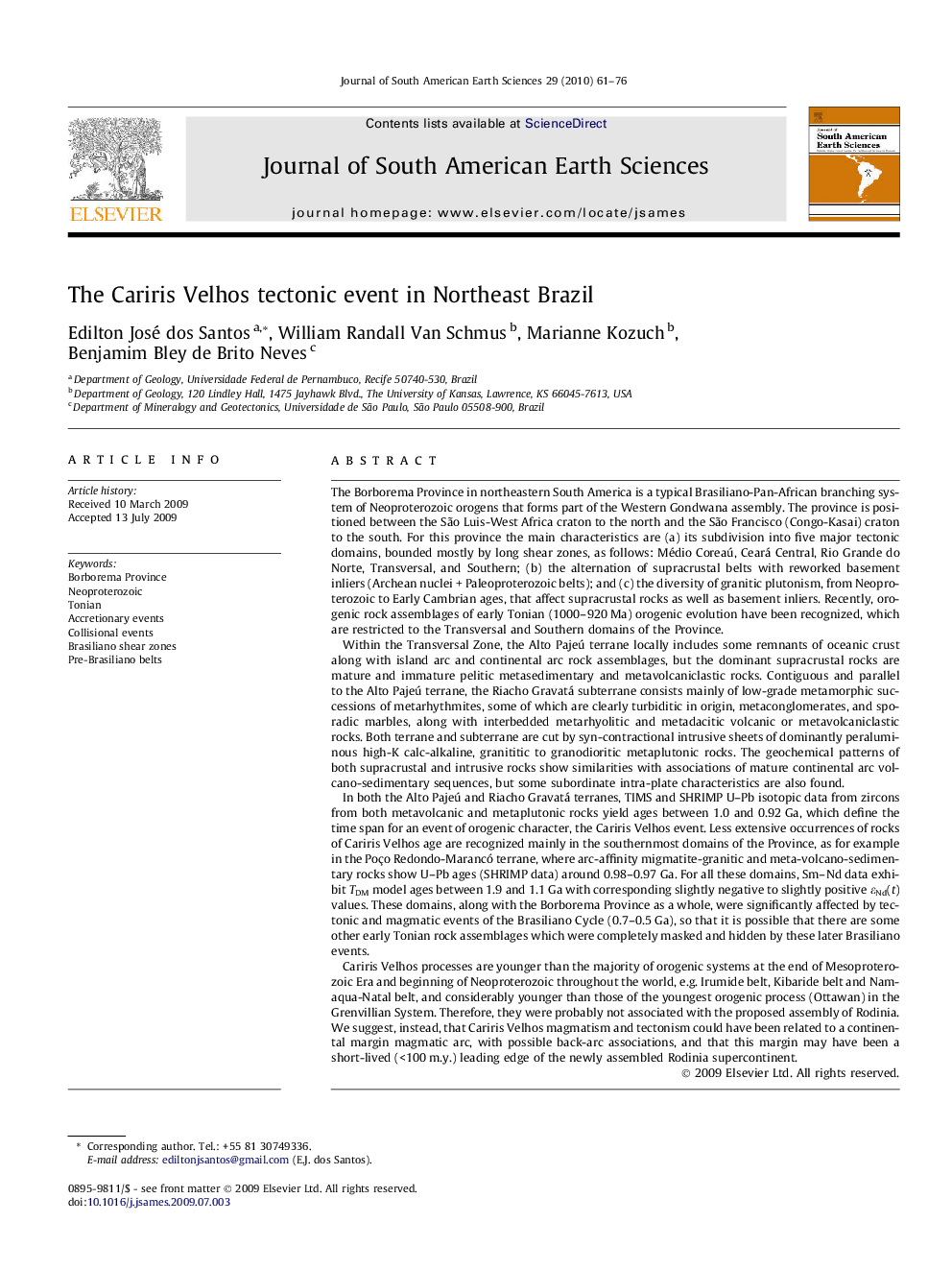| کد مقاله | کد نشریه | سال انتشار | مقاله انگلیسی | نسخه تمام متن |
|---|---|---|---|---|
| 4682753 | 1348941 | 2010 | 16 صفحه PDF | دانلود رایگان |

The Borborema Province in northeastern South America is a typical Brasiliano-Pan-African branching system of Neoproterozoic orogens that forms part of the Western Gondwana assembly. The province is positioned between the São Luis-West Africa craton to the north and the São Francisco (Congo-Kasai) craton to the south. For this province the main characteristics are (a) its subdivision into five major tectonic domains, bounded mostly by long shear zones, as follows: Médio Coreaú, Ceará Central, Rio Grande do Norte, Transversal, and Southern; (b) the alternation of supracrustal belts with reworked basement inliers (Archean nuclei + Paleoproterozoic belts); and (c) the diversity of granitic plutonism, from Neoproterozoic to Early Cambrian ages, that affect supracrustal rocks as well as basement inliers. Recently, orogenic rock assemblages of early Tonian (1000–920 Ma) orogenic evolution have been recognized, which are restricted to the Transversal and Southern domains of the Province.Within the Transversal Zone, the Alto Pajeú terrane locally includes some remnants of oceanic crust along with island arc and continental arc rock assemblages, but the dominant supracrustal rocks are mature and immature pelitic metasedimentary and metavolcaniclastic rocks. Contiguous and parallel to the Alto Pajeú terrane, the Riacho Gravatá subterrane consists mainly of low-grade metamorphic successions of metarhythmites, some of which are clearly turbiditic in origin, metaconglomerates, and sporadic marbles, along with interbedded metarhyolitic and metadacitic volcanic or metavolcaniclastic rocks. Both terrane and subterrane are cut by syn-contractional intrusive sheets of dominantly peraluminous high-K calc-alkaline, granititic to granodioritic metaplutonic rocks. The geochemical patterns of both supracrustal and intrusive rocks show similarities with associations of mature continental arc volcano-sedimentary sequences, but some subordinate intra-plate characteristics are also found.In both the Alto Pajeú and Riacho Gravatá terranes, TIMS and SHRIMP U–Pb isotopic data from zircons from both metavolcanic and metaplutonic rocks yield ages between 1.0 and 0.92 Ga, which define the time span for an event of orogenic character, the Cariris Velhos event. Less extensive occurrences of rocks of Cariris Velhos age are recognized mainly in the southernmost domains of the Province, as for example in the Poço Redondo-Marancó terrane, where arc-affinity migmatite-granitic and meta-volcano-sedimentary rocks show U–Pb ages (SHRIMP data) around 0.98–0.97 Ga. For all these domains, Sm–Nd data exhibit TDM model ages between 1.9 and 1.1 Ga with corresponding slightly negative to slightly positive εNd(t) values. These domains, along with the Borborema Province as a whole, were significantly affected by tectonic and magmatic events of the Brasiliano Cycle (0.7–0.5 Ga), so that it is possible that there are some other early Tonian rock assemblages which were completely masked and hidden by these later Brasiliano events.Cariris Velhos processes are younger than the majority of orogenic systems at the end of Mesoproterozoic Era and beginning of Neoproterozoic throughout the world, e.g. Irumide belt, Kibaride belt and Namaqua-Natal belt, and considerably younger than those of the youngest orogenic process (Ottawan) in the Grenvillian System. Therefore, they were probably not associated with the proposed assembly of Rodinia. We suggest, instead, that Cariris Velhos magmatism and tectonism could have been related to a continental margin magmatic arc, with possible back-arc associations, and that this margin may have been a short-lived (<100 m.y.) leading edge of the newly assembled Rodinia supercontinent.
Journal: Journal of South American Earth Sciences - Volume 29, Issue 1, January 2010, Pages 61–76